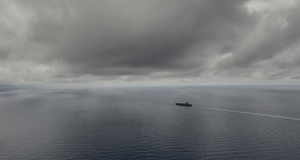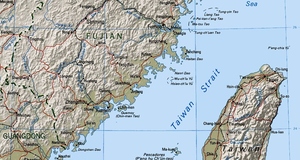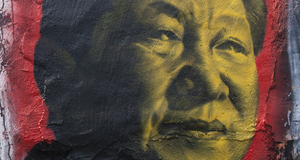Featured Article:Competing Claims in the South China Sea Viewed Through International Admiralty LawIII. These Are Exciting TimesAt its core, the dispute in the South China Sea appears to be a battle for control over vast oil and natural gas resources along with greater control over one of the worlds busiest shipping lanes.85 An estimated $5.3 trillion in total trade passes through the South China Sea each year.86 Along with that, experts estimate that there are 11 billion barrels of oil and 190 trillion cubic feet of natural gas available for exploitation beneath the seafloor.87 With this much wealth at stake, it is not hard to understand why the nations around the South China Sea are fighting for control over as much of it as possible. This has led to many unexpected legal, diplomatic, and military moves by all the parties in recent years. A. Seeking Black GoldOn May 2, 2014, China unilaterally decided to send an enormous oil rig on an exploration mission 120 nm off the coast of Vietnam “near islands claimed by both countries and well within [Vietnam’s] 200-mile exclusive economic zone set by international law.”88 While the rig was clearly within Vietnam’s EEZ, China claimed that the rig was operating “completely within its waters.” 89Approximately thirty Vietnamese vessels tried to intervene, “but were repelled by the eighty plus Chinese ships protecting the rig.”90 This move led to “the worst breakdown in relations [between China and Vietnam] since a brief border war in 1979,”91 and drew the ire of the international community. Amid mounting pressure, China cut the expedition short and withdrew the rig a month ahead of its original schedule.92 While some hypothesized that this bold move was a one-time occurrence, China deployed an oil rig again in the summer of 2015. This time, the rig appeared to be in an area “where the exclusive economic zones (EEZ) of Vietnam and China overlap, but further away than [in 2014].”93 Chinese officials declared the rig would carry out “‘ocean drilling operations’ 75 nautical miles south of the resort city of Sanya on southern Hainan island.”94 Because, unlike the 2014 incident, this rig was operating “within an EEZ claimed from Hainan Island rather than one from the hotly disputed Paracel Islands,”95 Vietnam’s response was not as strong.With the status of the islands and their ability to generate EEZs still unsettled, it is unclear which countries are entitled to exploit the regions vast energy resources. B. Springing Up Like WeedsAnother wrinkle in the dispute is the enormous land reclamation operation engaged by all has engaged in along with its construction of many artificial islands in the South China Sea. These creations are as much a marvel of engineering as they are confounding to the international system. Land reclamation is a popular strategy among the claimants in the South China Sea issue.96 The disputants are known to “build artificial islands and add to existing rocks and reefs to expand territory or bolster claims of ‘rightful’ territory.”97 China has demonstrated a mastery of this art that few ever thought possible. Statistics show that since this dispute began, “the combined territory reclaimed by [Malaysia, the Philippines, Taiwan and Vietnam] figures under 200 acres.”98 On the other hand, China has reclaimed “17 times more land in 20 months than the other claimants combined over the past 40 years, accounting for approximately 95 percent of all reclaimed land in the Spratly Islands.”99 These islands (both reclaimed and manmade) have been used by China to project power and attempt to bolster its legal claim to sovereignty over the vast majority of the South China Sea. Chinese troops can be found on many of the islands in question, and recent satellite images revealed the construction of a large airstrip on reclaimed land in the Spratlys.100 China has also used its control over Woody Island to claim an EEZ within the Paracels. As previously noted, Woody Island is capable of sustaining human life, and is home to the Chinese city of Sansha. In 2012, China upgraded Sansha to a prefecture-level city (ranking below a province but above a county) of Hainan Province.101 This move brings “the Xisha, Nansha, Zhongsha islands and their adjacent islets and waters…under the administrative jurisdiction of Sansha City.”102 It is also an attempt to legitimize Chinese control over the region by placing government functions on the islands and entrenching them in the domestic Chinese political system. Vietnam has protested this move, calling Sansha a garrison rather than a city and claiming that the whole affair is “a violation of international law…[that] seriously infringe[s] upon Vietnam’s sovereignty over the Paracel and Spratly island groups.”103 While China continues to expand on these islands, they are not “islands” under UNCLOS. As stated above, neither artificial islands nor submerged fixtures are entitled to any maritime zones.104 China’s land reclamation has raised several of these fixtures from the depths, but they would not have been above the waterline without human intervention. Because of the ongoing disputes in the region, the fact that these features are now above water and could be seen as islands is potentially irrelevant. The UNCLOS and previous judicial decisions suggest that land reclamation after a “critical date” in international disputes does not change the original status of the features in dispute. The Philippines filed a claim with the Permanent Court of Arbitration at The Hague in 2013 which could, legally speaking, freeze the South China Sea at the state it was in before China’s campaign of land reclamation. If this is the case, the capabilities of and happening on these islands will not factor into the court’s decision. The arbitration case against China will be discussed in greater detail the next section. It would seem that these artificial islands are being used to strengthen China’s de facto control over the region rather than China’s legal arguments. Many believe that the islands “have an unmistakable military purpose.”105 Navy Admiral Harry Harris, the commander of U.S. Pacific Command, told the US Senate that China is also “building deepwater ports and other military facilities in the sea as well.”106 These will enable Beijing to “have de facto control over the South China Sea in any scenario short of war.”107 The Philippines and others have asked the US on many occasions to take more of a stand against China’s territorial claims.108 The US has taken no direct position on the matter in the past, but has grown more vocal on the topic in recent years. In 2011, Secretary of State Clinton said:
Since 2012, the United States has avoided sailing within 12 nm of the China’s artificial islands despite America’s refusal to acknowledge them as Chinese territory.110 Recent flareups in the region and a fear of setting a dangerous precedent have motivated the Obama administration to break from its previous policy and begin sailing freedom of navigation patrols around the islands. In October 2015, the US sailed a guided-missile destroyer within 12 nautical miles of the artificial islands demonstrating that America does not recognize them as Chinese territorial waters.111 Displeased by this change in policy, China warned that the US should "not act blindly or make trouble out of nothing.”112 The Obama administration recently said “the freedom of navigation operations serve to protect the rights, freedoms and lawful uses of the sea and airspace, guaranteed to all nations under international law.”113 Currently, the official determination of the United States is that China’s claims are not in accordance with international law.114 C. The Philippines v. China - A David And Goliath TaleThroughout this dispute China has tended to “favor bilateral negotiations behind closed doors, [but] other countries want international mediation.”115The first country to make such a move is the Philippines. On January 22, 2013, the Philippines brought a claim against China to the Permanent Court of Arbitration under Annex VII of UNCLOS. The Philippines seeks a ruling on its EEZ and on the legality of China’s nine-dashed line. Specifically the Philippines seeks, among other things, a requirement that “China refrain from preventing Philippine vessels from exploiting in a sustainable manner the living resources in the waters adjacent to Scarborough Shoal and Johnson Reef, and from undertaking other activities inconsistent with the Convention at or in the vicinity of these features;” a declaration “that the Philippines is entitled under UNCLOS to a 12 M Territorial Sea, a 200 M Exclusive Economic Zone, and a Continental Shelf under Parts II, V and VI of UNCLOS, measured from its archipelagic baseline;” and a requirement that China vacate the islands wishing Philippines’ claim.116 In July of 2015, the court held hearings on the question of jurisdiction as a response to China’s claims “that the arbitral tribunal has no jurisdiction to resolve the case, as it cannot judge on issues of sovereignty.”117 China declined to participate on the grounds that it did not recognize the tribunal’s jurisdiction over the matter. On October 29, 2015, the tribunal unanimously held that it does have proper jurisdiction.118 The court held that the case was “properly constituted” under the United Nations Convention on the Law of the Sea, that China’s “non-appearance” did not preclude the Court’s jurisdiction, and that the Philippines was within its rights in filing the case.119 The matter has been compared to Nicaragua v. United States120” due to similarities of the parties involved such as that “a developing country is challenging a permanent member of the United Nations Security Council in an arbitral tribunal.”121 The Chinese government, “facing international legal scrutiny for the first time over its assertiveness in the South China Sea, would neither participate in nor accept the case.”122 According to Vice Foreign Minister Liu Zhenmin, "The result of this arbitration will not impact China's sovereignty, rights or jurisdiction over the South China Sea under historical facts and international law.”123 Other commenters see this as “"a major blow for China given that the opinion explicitly rejects China's arguments that ... the Philippines has not done enough to negotiate the issues with China.”124 The tribunal called for further hearings on the merits of the case for November 24-30 with a decision expected in 2016. This development is incredibly significant because, for the first time ever, “China’s nine-dash line getting its day in international court (although, notably, without China taking part to defend it).”125 China has “kept the scope of its nine-dash line ambiguous under formal and customary international law,” but once the Court decides on the matter, “its ability to maintain ambiguity will be limited.”126 The court will also be forced to examine China’s historical claims to these islands, which have previously not been scrutinized legally in any meaningful way.. While the tribunal’s decisions are binding, there exist no enforcement mechanisms, and nations have ignored them in the past.127 If the Philippines does win, it may only be an intellectual victory, but China would lose its ability to claim that its actions are in conformity with international law. This opens China up to diplomatic and economic pressure in the form of censures and ever sanctions.128 While China is a major world power, a united ASEAN could use this ruling as an opportunity to fight back economically and garner global support. Such a judgment in the Philippines’s factor would “likely be a millstone around China's neck, especially at regional meetings, because it would mark the first time an international court has intervened in the dispute, making it harder for Beijing to ignore.”129Continued on Next Page » Suggested Reading from Inquiries Journal
Inquiries Journal provides undergraduate and graduate students around the world a platform for the wide dissemination of academic work over a range of core disciplines. Representing the work of students from hundreds of institutions around the globe, Inquiries Journal's large database of academic articles is completely free. Learn more | Blog | Submit Latest in International Affairs |


















